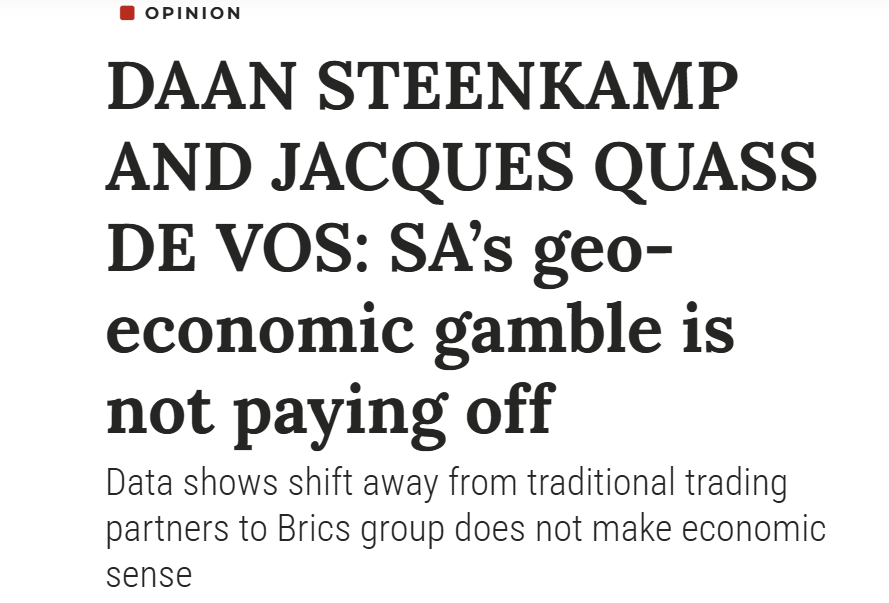Today’s blog post is an ungated version of a Business Day article in which I argue that despite claims to the contrary, issuing debt in one’s own currency is no protection against going bankrupt.
Printing money does not create jobs
At the heart of South Africa’s ongoing Budget debacle is a difference of perspectives on what the role of the Budget is in setting South Africa’s policy agenda. Most groups believe that the answer to South Africa’s problems is some combination of slowing the growth of government expenditure, raising taxes, and implementing economic reforms. Others argue that a major cause of our low growth is ongoing fiscal consolidation. An extreme version of this view is that South Africa is not facing fiscal constraints – that the government cannot default on domestic currency debt, and that the central bank should create money to directly lend to government and favoured industries.
Despite such claims, history shows that issuing debt in one’s own currency is no protection against going bankrupt. Countries tend to choose to default on domestic currency debt as it becomes politically infeasible to tolerate the inflation generated to try to keep government solvent. Based on experiences of countries that have defaulted, Reinhart and Rogoff (2010) show that that the ratio of domestic public debt to the monetary base is a useful indicator of the risk of runaway inflation, while a good indicator of debt default risk is the ratio of public debt to revenue. South Africa’s ratios of public debt to government revenue and domestic debt to the monetary base have almost tripled since 2007.

Like many other countries, South Africa’s current level of debt to revenue is much higher than the levels presented by Reinhart and Rogoff for countries that experienced debt defaults before the global financial crisis of 2008/9. As global interest rates begin to normalise, debt constraints will tighten.
The truth is there are limits to how much debt a country can bear. Eventually interest rates rise and debt service costs consume an ever-greater share of government revenues. We have seen this bearing out in South Africa. Debt service costs now exceed a fifth of government revenue from a tenth in 2012. Since 2007, the level of public debt per net personal taxpayer has risen more than fivefold to over R1 million for the most recently available data.
The fact that South Africa’s debt has been able to rise as much as it has is not proof that debt is not a constraint. If anything, South Africa has been incredibly lucky that global interest rates have been so low and the global environment so accommodating of our rising public debt.
Those that are argue that South Africa should take on more debt to fund more government expenditure underestimate the importance of the exchange rate and international capital markets. South Africa has higher foreign debt than many appreciate. Foreign creditor debt represents over 25% of government debt, with foreign currency debt representing about 10% of total. External debt per capita has more than tripled in USD terms since 2008 and use of IMF credit is already at about 1% of gross national income.
South Africa is already dependent on foreign borrowing and therefore vulnerable to changes in the global environment. We saw both domestic borrowing costs and the rand react immediately to the firing of the finance minister in December 2015. One reason South African long-term rates are so high is that investors are concerned about the possibility that the rand could depreciate strongly from political shocks or in response to elevated inflation risk. Forcing the central bank to try to reduce government borrowing costs would chase foreign investors away and achieve the opposite.
The idea that more government spending pays for itself is based on an over-optimistic view of fiscal multipliers – that government spending speeds up economic growth. Empirical evidence for South Africa does not support this contention. A recent paper by du Rand, Hollander and van Lill (2023) suggests that fiscal multipliers are not statistically different from zero.
Many forms of government spending have been woefully inefficient and higher debt has contributed to higher interest rates that represent a drag on growth. If anything, these estimates provide support to the idea that fiscal consolidation to bring down debt would be less painful than if multipliers were higher.
Those advocating for the use of tax policy to manage the economy also over-state how easy this might be. Even the recent small increase to Value Added Tax created political consternation. South Africa’s tax base is almost tapped out, with increased reliance on a small group of high-income taxpayers and large corporate taxpayers. The latest tax statistics for South Africa reveal that approximately around 350 000 taxpayers, earning over R1 million, contribute over 45% of total personal income tax revenues. Around 500 companies contributed almost 70% of the total company tax take in South Africa in 2023. South Africa is already at the point where more personal taxes do not raise more revenue.
As much as some might want to believe otherwise, there is no such thing as a free lunch. The idea that government spending pays for itself and that the central bank should fund government is a dangerous mirage. These ideas ignore that fiscal discipline and central bank credibility form the bedrock of local and foreign confidence in the value of the domestic currency.
Kickstarting growth and creating jobs will not come from tweaks to the Budget either. There is no short-cut: it requires that the government implement structural reforms that remove the impediments to growth and investment that it chooses to maintain.
Dr Steenkamp is CEO of Codera Analytics and a research fellow with the economics department at Stellenbosch University.

